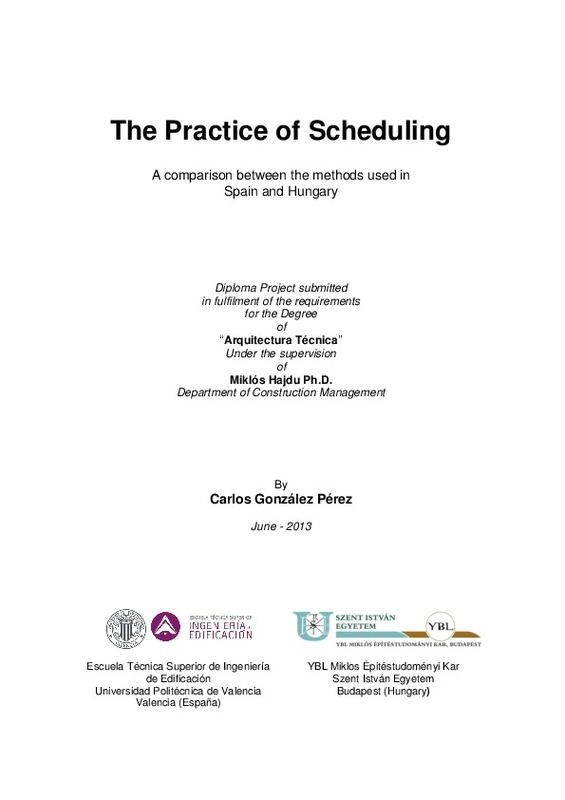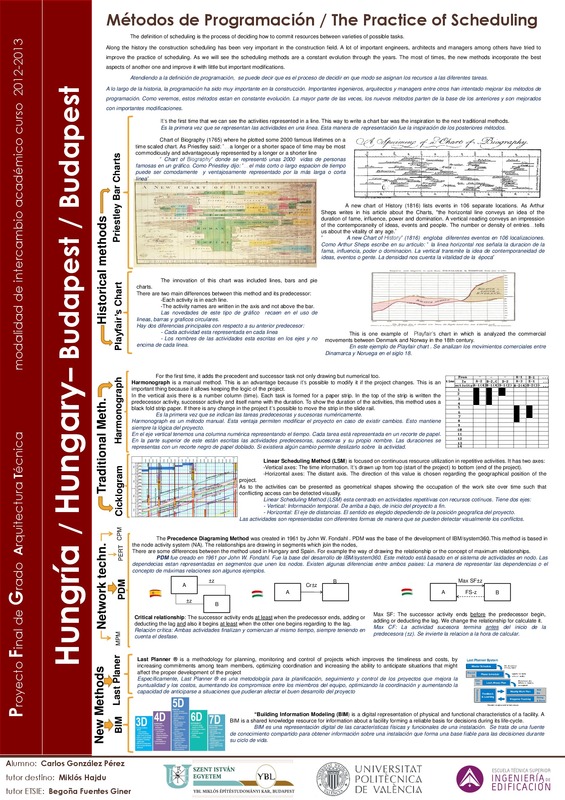JavaScript is disabled for your browser. Some features of this site may not work without it.
Buscar en RiuNet
Listar
Mi cuenta
Estadísticas
Ayuda RiuNet
Admin. UPV
The practice of scheduling : a comparison between the methods used in Spain and Hungary
Mostrar el registro sencillo del ítem
Ficheros en el ítem
| dc.contributor.advisor | Fuentes Giner, María Begoña
|
es_ES |
| dc.contributor.advisor | Hjdu, Miklós
|
es_ES |
| dc.contributor.author | González Pérez, Carlos
|
es_ES |
| dc.date.accessioned | 2014-01-31T09:16:04Z | |
| dc.date.available | 2014-01-31T09:16:04Z | |
| dc.date.created | 2013-07-02 | |
| dc.date.issued | 2014-01-31 | |
| dc.identifier.uri | http://hdl.handle.net/10251/35292 | |
| dc.description.abstract | TFG en intercambio académico. YBL Miklós Faculty of Architecture and Civil Engineering (Hungary) | es_ES |
| dc.description.abstract | [ES] Este TFG estudia los diferentes métodos usados en la historia de la programación desde los comienzos hasta los sistemas más modernos. Se ha revisado la evolución de las técnicas a lo largo de casi más de 3000 años. Tras haber estudiado todos estos períodos se puede extraer una conclusión central: la importancia de la programación. Desde las primeras construcciones, se ha tratado de optimizar el rendimiento de los materiales, equipos o mano de obra para llevar a cabo la tarea de construcción de la mejor manera. Sin embargo, los avances más importante en el campo de la planificación se han producido en los últimos tres siglos. Hoy en día hay dos métodos: Last Planner, sistema de control que mejora sustancialmente el cumplimiento de actividades y la correcta utilización de recursos de los proyectos de construcción; y Building Information Modeling (BIM) que es una representación digital de las características físicas y funcionales de una instalación. | es_ES |
| dc.description.abstract | [EN] In this Bachelor's thesis the different methods used during the history of scheduling, from the beginnings of the construction to the most modern systems, are studied. The evolution of the techniques throughout almost more than three thousand years is reviewed. After having studied all this years, a main conclusion can be drawn: the importance of the scheduling. Since the first constructions, people have tried to optimize the performance of the materials, equipment or laborers for carry out the construction tasks in the best way. However, the most important developments in the field of the scheduling construction were in the last three centuries. Nowadays there are two new methods: Last Planner system, used to achieve better performance in design and construction through increased schedule/programme predictability; and, Building Information Modeling (BIM), used as a digital representation of physical and functional characteristics of a facility. | es_ES |
| dc.format.extent | 74 | es_ES |
| dc.language | Inglés | es_ES |
| dc.publisher | Universitat Politècnica de València | es_ES |
| dc.rights | Reconocimiento - No comercial - Sin obra derivada (by-nc-nd) | es_ES |
| dc.subject | Proyectos de construcción | es_ES |
| dc.subject.classification | CONSTRUCCIONES ARQUITECTONICAS | es_ES |
| dc.subject.other | Grado en Ingeniería de Edificación-Grau en Enginyeria d'Edificació | es_ES |
| dc.title | The practice of scheduling : a comparison between the methods used in Spain and Hungary | es_ES |
| dc.title.alternative | Métodos de planificación | es_ES |
| dc.type | Proyecto/Trabajo fin de carrera/grado | es_ES |
| dc.rights.accessRights | Abierto | es_ES |
| dc.contributor.affiliation | Universitat Politècnica de València. Escuela Técnica Superior de Gestión en la Edificación - Escola Tècnica Superior de Gestió en l'Edificació | es_ES |
| dc.description.bibliographicCitation | González Pérez, C. (2013). The practice of scheduling : a comparison between the methods used in Spain and Hungary. http://hdl.handle.net/10251/35292. | es_ES |
| dc.description.accrualMethod | Archivo delegado | es_ES |
Este ítem aparece en la(s) siguiente(s) colección(ones)
-
ETSIE - Trabajos académicos [2383]
Escuela Técnica Superior de Ingenieria de Edificación







